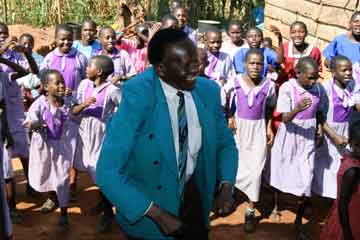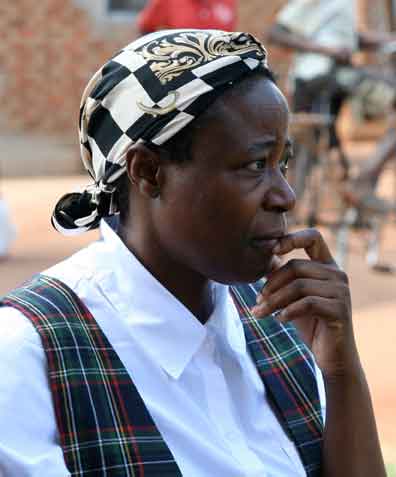Voices: Moving About |
| Printer-friendly version | Email this article |
|
In July, Wabash Media Specialist Jeana Rogers accompanied Sister Stella Sabina Santana and Wabash Professor James Makubuya to Kenya and Uganda to film a documentary about the struggles of women in those countries, where Wabash faculty and staff are partnering with Shifting Ideas Through Education for African Women (SITEAW) to work for change.
PEOPLE MOVE DIFFERENTLY IN AFRICA.
There are plenty of cars among Nairobi’s four million inhabitants, but the streets and dirt paths alongside them are alive with human faces. Every morning in the street outside the monastery where we stayed, 1,300 children in bright colored uniforms and oversized hand-me-down shoes shuffle along the road to school. Some run and play as they move along the dirt walks, or make their own paths across the grass. The city is criss-crossed with do-it-yourself walkways.
From the road outside the city you see houses, miles away, with no apparent way to reach to them. The people walk along narrow paths from the main road to the farms. The walkways are old, some so deep their edges reach to the walkers’ knees.
The people move differently here.
We headed out to a local government- run primary school with Olivia walking at her confident, purposeful pace. She has built the Women’s Awareness Center face-to-face, one relationship at a time, organizing the women to make the bricks and construct the buildings, leading meetings with them, walking to the schools or riding a boda boda bike taxi to lobby government officials or meet with the banker who provides the women small business loans. She’s built and run the Center without a car or a cell phone in a place where people who barely have a roof over their heads often have a cell phone. She can’t afford one.
Olivia led us to the government school, where 1,300 children ran on the sprawling play yard. Some had bowls of various shapes and sizes in their hands and were forming two long lines. The taller boys herded the younger ones into the lines with a stick, the same way they herd cows in the streets.
A teacher scooped up a spoon full of rice and corn from a large iron pot and dumps it into each child’s bowl. Provided by the World Food Program, this was the only meal that most of the children would get today. The head mistress pointed past the schoolyard to some shacks with tin roofs and old boards for walls—the slum area most of the children came from. The children eagerly used their three-fingered spoons to scoop up their free meal. Many offered to share it with us. As we left the head mistress invited us to come back anytime. She was proud of her school.
LATER THAT WEEK WE TRAVELED to Iganga, Uganda, where SITEAW has been constructing the Women’s Awareness Center. We moved about in our rented SUV as people waited for the arrival of the visitors from America.We rode down a dirt road to group of small buildings where Olivia’s father, John Kabaale had invited us to visit his orphanage.
John is a retired teacher who after his retirement built a small home for himself and his wife. Soon afterward people began bringing him orphaned children, many whose parents had died of AIDS. His retirement home became an orphanage and a school for about 40 children. They live and learn there. His bedroom is now a small office.
As the orphans keep coming he has tried to expand. A small structure made of discarded tin and wood has been added to one of the concrete buildings, its wood walls serving as shelter from the elements outside and a chalkboard on the inside. About 15 children sleep on the dirt or concrete floors of their classrooms at night. There were no desks, or notebooks to write in, no library, no school supplies, and very little food. There were no organizations like Feed the Children or the World Food Program here. They just don’t reach the smaller villages in Africa.
MOUNT ELGON SITS ON THE BORDER OF KENYA AND UGANDA, an extinct volcano that attracts visitors from around the world.The view on the ride up the mountain is beautiful.
We left the car and walked through maize fields and forest until we entered a clearing overlooking the mountainside and the flatlands below. About 30 feet away a woman was sipping water from a container that looked like a gourd. She began spitting it in our direction as we approached—a blessing upon her guests, I was told later. At the time, I was just glad we weren’t closer.
She motioned us over to sit under a tree, and her dress made of dried animal skins crinkled as she shooed away some chickens and sat on the grass.
The surgeon was very proud of her position as a cutter in her tribe. Surgeons are well respected and earn a good living from cutting young girls that come to her during circumcision years. I could see in her face the pride she takes in her work. In the shadow of this beautiful mountain, she boasted about cutting hundreds of girls quickly and efficiently. She described how she had been "called by the spirits" to cut young girls. This woman was content, proud, even fulfilled, by her vocation. She showed us a small bowl with several double-edged razor blades in it—the tools of her trade.
IN NAROK, KENYA, WE HEARD THE OTHER SIDE of this story, as we interviewed three young girls from the Masaai tribe. Now in their early 20s, these young women had been circumcised at the age 11 or 12. As young girls they had gladly joined in the singing and dancing that is the traditional part of the circumcision ceremony. None had a clue that later that day, they would have their genitals cut off. It was the tradition. All of them described how they were circumcised against their will. How they passed out from the pain and were sick and weak from blood loss. Some girls in their tribe have died from this procedure.
These young women hope that by speaking out, they might save their younger siblings and others from this procedure. They are working within their tribe to help young girls stay in school. They are pleading that these girls be given a choice.
It all comes back to education. What the Women’s Center is all about. The young girls didn’t know they might have a choice; they didn’t know their rights. Widows don’t know that they are being cheated out of an inheritance; they cannot read the will. Women are often forced to stay with men who abuse them because they had no skills to support themselves and provide for their children. Education is the key to having a choice.
OLIVIA KABALA IS AN AMAZING WOMAN. She is unpaid as director of the Center; it’s in her heart. She is passionate about empowering women in her country.You hear it in her voice.You see it in her eyes. You see it as she moves about. I wanted to help.
So I bought her a cell phone. I thought she could be more productive with better communication. It’s the techie in me.
Her family and others she works with were pleased when they heard about her new cell phone. They have sent me jewelry, an African dress, and 100 hugs as a blessing for this gift. I get several hugs each time I meet at Wabash with Sister Stella, the founder of SITE for African Women, to continue our editing of the film.
But I realize my gift carries an inherent risk. I have changed the way Olivia moves, the way she communicates. I can only hope her deeply personal way of moving about is enhanced, not diminished by this technology.
For she has changed the way I move. Africa used to feel so far away to me, its problems so overwhelming and I too unimportant to do anything about them. But I’ve seen how the chain of events affects everybody.
And through Olivia, I’ve seen how we can make a difference, moving from one person to another.
The College has a great opportunity to make a difference in Uganda as well by working with Shifting Ideas Through Education for African Women. Students have a remarkable opportunity to learn about the culture and traditions of an amazing people.They can help build facilities, teach women vocational and business skills, and immerse themselves in an experience of a lifetime through educating others. I believe they, like me, will be moved and receive blessings 100 times greater than anything they give.
AT ONE OF THE VILLAGES WE VISITED, an elderly woman greeted me by kneeling at my feet. I’d been told that this might happen. It’s a gesture of deep respect reserved for honored guests and elders in the village. It made me very uncomfortable. I asked Sister Stella the proper thing to do.
"If someone kneels before you," she said, "just take her hand and help her up."
—Contact Jeana Rogers at rogersj@wabash.edu
Learn more about the College’s partnership with SITEAW at www.siteaw.org or read the blog from the trip at www2.wabash.edu/blog/africa2006.
Top Photo: John Kabaale and his "children" welcome us.
Lower Photo: Sister Stella
|

 I realized this 15 hours after landing in Nairobi to film a documentary for the Women’s Awareness Center in Iganga, Uganda. Olivia Kabaale, the Center’s director, knocked on the door of our room at the monastery and asked if we would like to go somewhere. She calls it "moving about."You don’t "go" anywhere here. You just move.
I realized this 15 hours after landing in Nairobi to film a documentary for the Women’s Awareness Center in Iganga, Uganda. Olivia Kabaale, the Center’s director, knocked on the door of our room at the monastery and asked if we would like to go somewhere. She calls it "moving about."You don’t "go" anywhere here. You just move. Most of the people here belong to the Sabiny tribe, a people with a long tradition of female circumcision. Today we were interviewing several of the "surgeons" who circumcise the girls.
Most of the people here belong to the Sabiny tribe, a people with a long tradition of female circumcision. Today we were interviewing several of the "surgeons" who circumcise the girls.